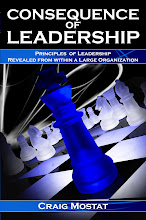Recently, I was engaged in a conversation with an employee and an assistant manager of a well-known Canadian retail company. Since I am well acquainted with all of them (employee, assistant manager and company), I decided to ask them a question, partly for the sport / part to prove a point.
Me: "What is your company's mission or purpose?"
Employee: "uhmmm, to sell stuff."
Me: "Ok, but what kind of stuff and to whom and for what purpose?"
Employee: "Oh I know" … she then quotes, word for word, a five-year-old redundant mission statement.
I explain the fact that this is no longer the mission statement and then ask again. She has no idea – which is not actually surprising because there really isn't one – or at least one that means anything.
I ask one more question: "What do you think that the customer believes this organizations mission statement to be?"
She then quotes, word for word, the company mission statement / slogan from over 15 years past – one long forgotten by the organization – but strangely still printed prominently on the front of many of the stores (only because of a lack of will to have the signage removed).
Confusing? You bet.
I love posing this question, especially to managers and executives. In companies that do not have a clarified and well communicated vision, mission or purpose, this question will often push the "yes people" into a state of anxiety and mortification when through that questioning, they come to a realization that they are operating without any purpose or direction. It is interesting that so many can carry out "busy-work" every day, with no understanding of purpose or vision for the future, and yet, seem to find fulfillment in the myriad of those often directionless projects and activities. That is the "sport" part – waking people up from this level of bureaucratic unconsciousness.
The assistant manager in this example simply watched with interest as he had already read my book and had this same conversation with his boss (the store manager) the previous day. Between the two of them, they could not come up with the answer. Some people would actually think it odd that the top two executives in a multi-million dollar business have no idea what they are really there to do.
Unfortunately, this company is not alone in this ambiguity of purpose, and not surprisingly this absence of a clearly communicated "purpose" correlates to diminishing profitability.
Your organization's stated mission should be simple and clear – easy to understand and embrace by anyone in the organization – including the front line employee. It should provide guidance and direction for your company; where it should go and perhaps more importantly – where it should not.
Everyone is responsible for it and to it. Senior leadership: to ensure that it is right, clear, concise – well communicated and well understood by everyone. Everyone else: to ensure that you understand it, can articulate both it and how it applies to what you do everyday.
If you do not know or understand your organization's mission statement, I suggest that you find out – today.
I have written much more on the subject of mission statements in the chapter "Focus and Clarity" of my book – "Consequence of Leadership."




No comments:
Post a Comment